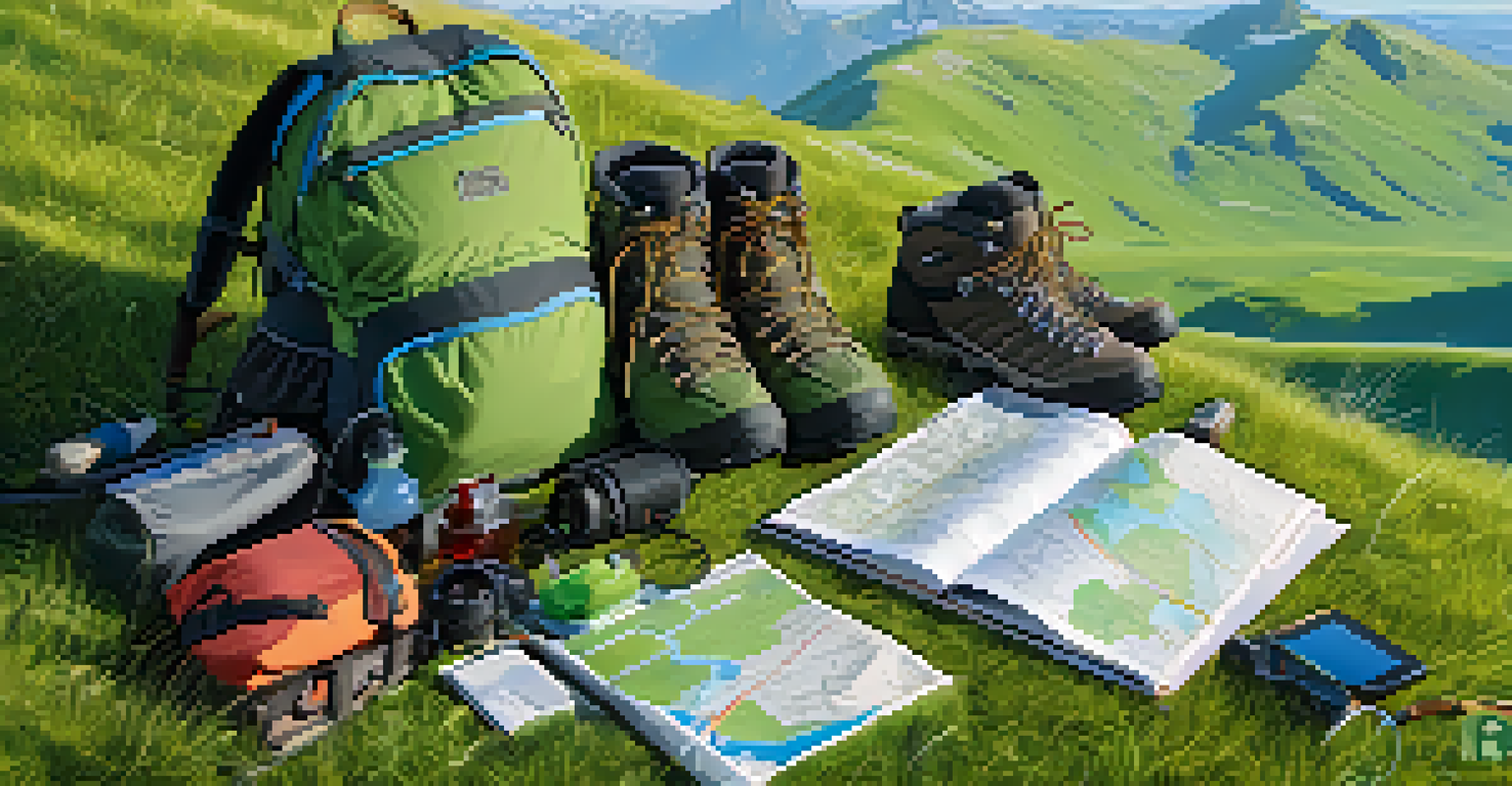Packing for High Altitude: What to Bring

Understanding High Altitude Packing Essentials
Packing for high altitude adventures requires a bit of forethought. The conditions can change rapidly, and being prepared is key to both safety and enjoyment. From temperature fluctuations to the need for specialized gear, understanding these essentials will set you up for success.
The mountains are calling and I must go.
When venturing to high altitudes, it's important to consider factors like oxygen levels and weather patterns. The air gets thinner as you ascend, which can affect both your stamina and comfort. Therefore, your packing list should reflect not just what you want, but what you truly need.
Ultimately, the right gear can make a world of difference. Packing with the unique challenges of high altitudes in mind ensures you’re ready for anything, allowing you to focus on the stunning views and exhilarating experience.
Layering Clothing: A Key to Comfort
Layering is crucial when it comes to dressing for high altitudes. The temperatures can vary significantly from base to summit, so having multiple layers allows you to adjust your clothing to maintain comfort. Start with a moisture-wicking base layer to keep sweat at bay.

Next, add an insulating layer, like a fleece or down jacket, which provides warmth without adding bulk. Finally, finish off with a waterproof and windproof outer layer to protect against the elements. This three-layer system is both efficient and effective.
Pack Smart for High Altitude
Being well-prepared with the right gear ensures safety and enhances your overall experience at high altitudes.
Remember, it’s not just about warmth; it’s also about breathability. High altitude hikes can be strenuous, so ensure your layers allow for ventilation as you work up a sweat while enjoying the stunning scenery.
Footwear: Choose the Right Hiking Boots
Your choice of footwear can make or break your high altitude experience. Invest in a pair of sturdy, well-fitting hiking boots that provide good ankle support and traction. The terrain can be unpredictable, and you want to ensure your feet are well protected.
In every walk with nature one receives far more than he seeks.
Consider breaking in your boots before the trip to avoid blisters and discomfort. A comfortable boot will allow you to focus on the adventure rather than your aching feet. Don’t forget to pack extra pairs of moisture-wicking socks to keep your feet dry.
Remember, high altitude hikes can involve rocky paths, so look for boots with a rugged sole. Proper footwear not only ensures safety but also enhances your overall hiking experience, allowing you to tackle any trail with confidence.
Hydration: Stay Energized with Proper Water Supply
Staying hydrated is essential at high altitudes, where the air is drier and your body can lose moisture more quickly. Pack a reliable water bottle or hydration reservoir to ensure you have access to water throughout your hike. Aim for about three liters per day, depending on your level of exertion.
Consider bringing water purification tablets or a filter, especially if you plan to source water from streams or lakes. This not only saves weight by reducing the amount of water you carry but also ensures that you're drinking safe, clean water.
Layer Up for Temperature Changes
Utilizing a three-layer clothing system allows you to adjust easily to the varying temperatures from base to summit.
Additionally, electrolyte tablets can be a great addition to your hydration strategy. They help replenish essential salts and minerals lost through sweat, keeping you energized and ready to tackle those breathtaking mountain views.
Essential Gear: Safety and Navigation Tools
When heading to high altitudes, packing the right gear is vital for safety and navigation. A map and compass should always be in your pack, even if you plan on using a GPS device. Technology can fail, and knowing how to navigate the old-fashioned way can be a lifesaver.
Consider carrying a first aid kit for any minor injuries, as well as a multi-tool for unexpected repairs. A headlamp is also invaluable, especially if you find yourself hiking during low light conditions. These items can significantly enhance your safety and overall experience.
Additionally, don’t forget a whistle, which can be crucial for signaling for help if needed. Being prepared with the right gear not only enhances safety but also gives you peace of mind, allowing you to fully enjoy your adventure.
Food Choices: Fuel Your High Altitude Adventure
Food choices play a significant role in keeping your energy levels up while hiking at high altitudes. Aim for lightweight, high-calorie snacks, such as nuts, energy bars, or dried fruits. These foods are easy to pack and provide the necessary fuel for your body to operate efficiently.
Consider packing meals that are easy to prepare, like dehydrated meals that just require hot water. These are not only light but also provide a warm, hearty option after a long day on the trail. Eating regularly will help maintain your energy and mood during your hike.
Stay Hydrated and Energized
Maintaining hydration and fueling your body with high-calorie snacks is crucial for stamina during high altitude hikes.
Lastly, don’t underestimate the power of a treat. Bringing along a small indulgence, like chocolate or your favorite candy, can be a great morale booster during tough stretches of your adventure.
Sun Protection: Shield Yourself from UV Rays
At high altitudes, the sun's UV rays are more intense, making sun protection a must. Pack a high-SPF sunscreen to protect your skin from harmful rays, even on cloudy days. Remember to reapply regularly, especially after sweating or wiping your face.
In addition to sunscreen, consider bringing sunglasses with UV protection to shield your eyes. Glare from the snow or rocky terrain can be quite harsh, and protecting your vision is just as important as caring for your skin.

Don’t forget a wide-brimmed hat to provide shade for your face and neck. Combining these protections helps ensure you can fully enjoy your adventure without worrying about sunburn or long-term skin damage.
Emergency Items: Be Prepared for the Unexpected
High altitude environments can be unpredictable, so it's crucial to pack emergency items. A basic first aid kit is a must, but you might also want to include a space blanket, which can help retain body heat in case of an emergency. These lightweight items can be life-saving.
Additionally, consider a portable phone charger, as charging options may be limited on the trail. This way, you can ensure your phone remains functional for navigation and emergencies. If you're venturing into remote areas, a satellite phone or personal locator beacon can be a wise choice.
Lastly, having a plan for emergencies is just as important as packing the gear. Familiarize yourself with your surroundings and share your itinerary with someone who isn’t joining you, so they know where you are and when to expect you back.